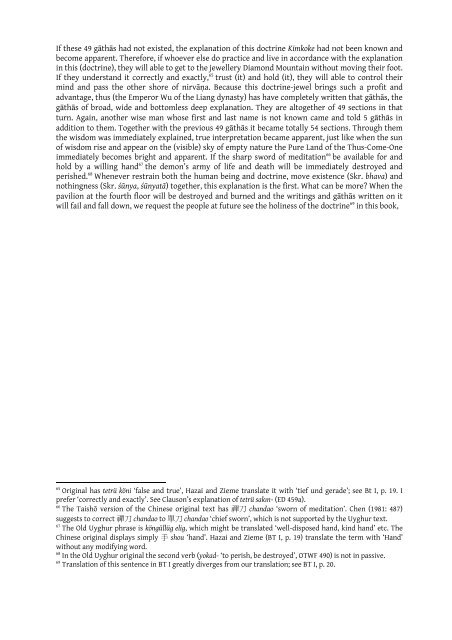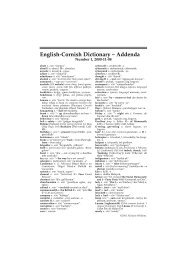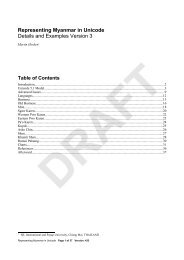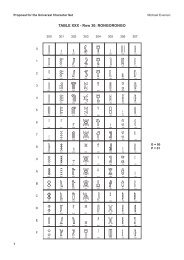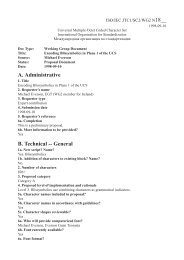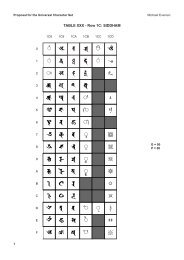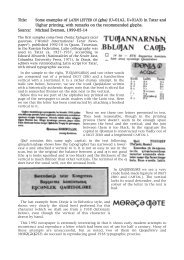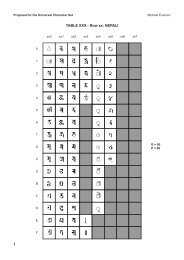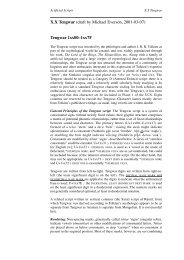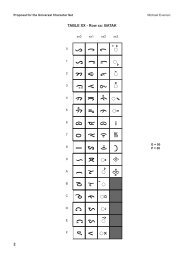The Vajracchedikā-sūtra with gāthās compiled by Master Fu - Evertype
The Vajracchedikā-sūtra with gāthās compiled by Master Fu - Evertype
The Vajracchedikā-sūtra with gāthās compiled by Master Fu - Evertype
You also want an ePaper? Increase the reach of your titles
YUMPU automatically turns print PDFs into web optimized ePapers that Google loves.
If these 49 <strong>gāthās</strong> had not existed, the explanation of this doctrine Kimkoke had not been known and<br />
become apparent. <strong>The</strong>refore, if whoever else do practice and live in accordance <strong>with</strong> the explanation<br />
in this (doctrine), they will able to get to the jewellery Diamond Mountain <strong>with</strong>out moving their foot.<br />
If they understand it correctly and exactly, 65 trust (it) and hold (it), they will able to control their<br />
mind and pass the other shore of nirvāṇa. Because this doctrine-jewel brings such a profit and<br />
advantage, thus (the Emperor Wu of the Liang dynasty) has have completely written that <strong>gāthās</strong>, the<br />
<strong>gāthās</strong> of broad, wide and bottomless deep explanation. <strong>The</strong>y are altogether of 49 sections in that<br />
turn. Again, another wise man whose first and last name is not known came and told 5 <strong>gāthās</strong> in<br />
addition to them. Together <strong>with</strong> the previous 49 <strong>gāthās</strong> it became totally 54 sections. Through them<br />
the wisdom was immediately explained, true interpretation became apparent, just like when the sun<br />
of wisdom rise and appear on the (visible) sky of empty nature the Pure Land of the Thus-Come-One<br />
immediately becomes bright and apparent. If the sharp sword of meditation 66 be available for and<br />
hold <strong>by</strong> a willing hand 67 the demon’s army of life and death will be immediately destroyed and<br />
perished. 68 Whenever restrain both the human being and doctrine, move existence (Skr. bhava) and<br />
nothingness (Skr. śūnya, śūnyatā) together, this explanation is the first. What can be more? When the<br />
pavilion at the fourth floor will be destroyed and burned and the writings and <strong>gāthās</strong> written on it<br />
will fail and fall down, we request the people at future see the holiness of the doctrine 69 in this book,<br />
65<br />
Original has tetrü köni ‘false and true’, Hazai and Zieme translate it <strong>with</strong> ‘tief und gerade’; see Bt I, p. 19. I<br />
prefer ‘correctly and exactly’. See Clauson’s explanation of tetrü sakın- (ED 459a).<br />
66 <strong>The</strong> Taishō version of the Chinese original text has 禪 刀 chandao ‘sworn of meditation’. Chen (1981: 487)<br />
suggests to correct 禪 刀 chandao to 單 刀 chandao ‘chief sworn’, which is not supported <strong>by</strong> the Uyghur text.<br />
67<br />
<strong>The</strong> Old Uyghur phrase is köngüllüg elig, which might be translated ‘well-disposed hand, kind hand’ etc. <strong>The</strong><br />
Chinese original displays simply 手 shou ‘hand’. Hazai and Zieme (BT I, p. 19) translate the term <strong>with</strong> ‘Hand’<br />
<strong>with</strong>out any modifying word.<br />
68<br />
In the Old Uyghur original the second verb (yokad- ‘to perish, be destroyed’, OTWF 490) is not in passive.<br />
69<br />
Translation of this sentence in BT I greatly diverges from our translation; see BT I, p. 20.


